Latitudinal Dependence of the Ionospheric Slab Thickness for Estimation of Ionospheric Response to Geomagnetic Storms
Abstract
1. Introduction
2. Experiments
3. Results
3.1. τ(med) Estimation for Different Latitudes
3.2. TEC Variations
3.3. foF2 Variations
3.3.1. foF2 Reconstruction Validation
3.3.2. Latitudinal foF2 Variations
4. Discussion
4.1. foF2 Response to the Storms during 7–17 March 2012
4.2. foF2 Response to the Storm during 21–31 March 2012
- (1)
- The ionospheric responses to MP and RP of geomagnetic storms differed. The change in the ionospheric reaction was quite clear in four cases.
- (2)
- The ionosphere responded to the MP of each storm 2 h after its beginning (later in one case). It also changed its behavior ~2 h after the storm’s RP beginning in four cases (Figure 12a,d).
- (3)
- The ionosphere returned to its regular state rather quickly after each geomagnetic storm. Therefore, though the short period of 7–17 March was characterized by a series of geomagnetic disturbances, it was possible to distinguish the response to each particular storm.
- (4)
- The ionospheric structures such as MIT and the border of the northern crest of EIA were more prominent during all storms (higher electron density gradients) instead of being smoothed and sometimes shifted as on non-storm days. Sometimes they manifested themselves in much sharper forms and/or were shifted in latitude if compared to their quiet regular patterns. For instance, foF2 curves in Figure 12b,c,e,f.
- (5)
- The response to storm №5 developed at an already non-quiet ionospheric background: foF2 values were increased under quiet geomagnetic conditions most of the time especially at high latitudes. During the storm, the foF2 values were exactly the opposite to these background variations: decreased at high latitudes instead of being increased and increased more intensively than during geomagnetically quiet days at lower latitudes. Eventually, this confirms the preliminary conclusion indicating that the ionospheric behavior was probably controlled by O/N2 changes along the 70° W longitude due to geomagnetic storm impact.
5. Correlation between the Ionospheric and Space Weather Parameters
5.1. Paired Correlation Analysis
5.2. Multiple Correlation Analysis
- (a)
- In our case, ∆foF2(rec) was considered as a “dependent” parameter (response variable) which was influenced by a set of SW parameters variations (explanatory variables). Considering the solar wind and interplanetary environment triggers of each geomagnetic storm discussed in Section 2 (Figure 2), we selected IMF, Bz, Np, V and AE to be included into the set of explanatory variables. F10.7-index was not involved as it characterizes the longer-term variations of solar activity than the considered 11-day periods. Dst-index was not involved because we already included AE; and Dst and AE variations were very similar which preferably should be avoided for explanatory variables in PCA. Thermospheric ratio O/N2 played a significant role in the ionospheric behavior (see Section 3). Consequently, it was included in the explanatory variables set, but only for the analysis at high and mid latitudes. This is because the ratio almost did not change at low latitudes and there were too many gaps of GUVI/TIMED satellite data at very high latitudes.
- (b)
- Further, the data were standardized, which means transformation of data distribution into the new distribution with zero mean and single (unitary) standard deviation. This results in that all explanatory variables have the same statistical weight in order to highlight the variance contrast.
- (c)
- Then, the principal components (PCs) were calculated for this new dataset. Each PC is a linear combination of the uncorrelated original explanatory variables, which forms an eigenvector of the covariance–correlation matrix. The response variable can be expressed via PCs as follows:where a–f are the multivariate regression coefficients of response variable ∆foF2 in terms of PCs. Each PC is a multi-dimensional vector. Example is given in Figure 15a. Each plane corresponds to a particular original explanatory variable. As the data were standardized, ∆foF2 values are expected to be clustered in the directions of the original explanatory variables, which is what exactly seen in the plot. Each PC can be expressed as an intermix of the original variables. The following offers an example:∆foF2 = a × PC1 + b × PC2 + c × PC3 + d × PC4 + e × PC5 (+ f × PC6),where Lij are the loadings of PCi in terms of the original explanatory variables (IMF, Bz, Np, V and AE), or in other words, the correlation coefficients between IMF, Bz, Np, V, AE and PCs. Figure 15b shows the example of the covariance matrix containing the loadings for time series of ∆foF2 during 7–17 March 2012: Each column represents the loadings for a particular PC.PC1 = L11 × AE + L12 × V + L13 × Np + L14 × Bz + L15 × IMF (+ L16 × O/N2),
- (d)
- The scree plot is a graph that shows the magnitudes of the eigenvalues of the covariance–correlation matrix. For example, Figure 15c illustrates the level of each PC impact on the response variable (percentage of ∆foF2 variance explained by a particular PC). Usually, it is supposed that it is sufficient to consider the components that explain 85% of the response variable variations; and the components of minor influence may be neglected. Though three first PCs mostly explained more than 85% of ∆foF2 variations, we considered five components. This is because in our case the same original explanatory variable could contribute significantly to several PCs (for instance, IMF in PC1, PC3 and PC4 in Figure 15b) [50]. The analysis showed that the consideration of less than five components resulted in the false intensification or decrease of the role of such explanatory variables.
- (e)
- Formulae 5 and 6 describe the PCA decomposition and a consequent regression step represented by PCR. Preferably, the explanatory variables should be totally independent from each other. From the physical point of view, in our case they are not absolutely independent because eventually they represent different processes that define Space Weather conditions. That is why, the direct comparison of IMF, Bz, Np, V and AE contributions to PCs (values of their loadings in each column of the matrix) resulted in the confusing results meaning that PCA was not sufficient to draw the conclusions. To eliminate the multicollinearity between our explanatory variables, PCR [51] was performed which is basically an extension of PCA. In PCR analysis, instead of regression of the dependent ∆foF2(rec) on the explanatory variables directly, the principal components or eigenvectors (v) of their variance–covariance matrix coefficients of explanatory variables (Figure 15b) are used as regressors (Equation (6)). Typically, only a subset of all the principal components is used for regression, making PCR a kind of regularized procedure or shrinkage estimator. According to equation 6, the final regression coefficients were obtained by multiplying PC values calculated for ∆foF2(rec) by the corresponding loading values (Figure 15d). ∆foF2(rec) of the particular latitude and time delay from the storm beginning were analyzed separately.
- (f)
- Finally, the contribution of variations of each SW parameter on the ionospheric response was presented in the form of percentage of the “explained” variance of ∆foF2(rec), based on the regression coefficient values obtained in PCR. Considering the contribution of each parameter to a particular PC, the dominant contributions or, in other words, the factors that had a dominant influence on foF2 at the particular latitude can be qualitatively estimated.
5.2.1. 7–17 March 2012
5.2.2. 21–31 March 2012
6. Conclusions
- Latitudinal dependence of the median value of the ionospheric slab thickness was obtained with use of polynomial approximation. The polynomial of third degree provided the confidence factor close to 1 for all UT hours except 12 UT (~7 LT), when the linear approximation with the confidence factor of 0.98 was sufficient.
- The synchronicity of changes of experimental TEC and foF2 values (changes of their behavior) was shown by data of four ionosondes during disturbances.
- The suggested method of construction of τ(med) latitudinal dependence applied to the analysis of foF2 during the disturbances of March 2012 allowed us to reveal the latitudinal features, which generally confirm the results of studies of such variations performed for local regions or for separated magnetic storms. In particular, (a) MIT structure and the border of the EIA northern crest manifested themselves in the much sharper and prominent forms and/or were shifted in latitude during all storms (higher electron density gradients). (b) Ionospheric response was delayed by 2 h from the storm’s beginning, in most cases (by 5–6 h in one case). The responses to the main and recovery phases in most cases was different. (c) The response to the storm of 27–28 March developed at an already non-quiet ionospheric background and was controlled by O/N2 changes due to geomagnetic storm impact.
- A qualitative assessment of the differences in the degree of influence of SW parameters variations on the ionosphere of different latitudes for two periods was obtained. The results of multiple correlation analysis for 7–17 March and 21–31 March differed significantly, but in both cases, during the geomagnetic disturbances, O/N2 variations in the considered longitudinal sector played a significant role in the ionospheric state change at mid latitudes. During the first period, the solar wind speed played the dominant role at high and very high latitudes. At high, mid and low latitudes, the impacts of several phenomena were difficult to separate. This combination of impacts depended on day/night conditions. During the second period, the geomagnetic storm developed on the quiet geomagnetic background, and the role of geomagnetic field changes was dominant.
Author Contributions
Funding
Institutional Review Board Statement
Informed Consent Statement
Data Availability Statement
Acknowledgments
Conflicts of Interest
References
- Cannon, P. Extreme Space Weather: Impacts on Engineered Systems and Infrastructure. Report; Royal Academy of Engineering, Prince Philip House: London, UK, 2013; Available online: www.raeng.org.uk/spaceweather (accessed on 19 November 2020).
- Goodman, J.M. Operational communication systems and relationships to the ionosphere and space weather. Adv. Space Res. 2005, 36, 2241–2252. [Google Scholar] [CrossRef]
- Klimenko, M.; Klimenko, V.; Zakharenkova, I.; Ratovsky, K.; Korenkova, N.A.; Yasyukevich, Y.; Mylnikova, A.; Cherniak, I. Similarity and differences in morphology and mechanisms of the foF2 and TEC disturbances during the geomagnetic storms on 26–30 September 2011. Ann. Geophys. 2017, 35, 923–938. [Google Scholar] [CrossRef]
- Jin, H.; Maruyama, T. Different behaviors of TEC and NmF2 observed during large geomagnetic storms. J. Int. Nat. Inst. Info. Comm. 2009, 56, 369–376. [Google Scholar]
- Cander, L.R.; Ciraolo, L. Ionospheric total electron content and critical frequencies over Europe at solar minimum. Acta Geophys. 2010, 58, 468–490. [Google Scholar] [CrossRef]
- Chen, P.; Liu, H.; Ma, Y.; Zheng, N. Accuracy and consistency of different global ionospheric maps released by IGS ionosphere associate analysis centers. Adv. Space Res. 2020, 65, 163–174. [Google Scholar] [CrossRef]
- Khattatov, B.; Murphy, M.; Gnedin, M.; Sheffel, J.; Adams, J.; Cruickshank, B.; Yudin, V.; Fuller-Rowell, T.; Retterer, J. Ionospheric nowcasting via assimilation of GPS measurements of ionospheric electron content in a global physics-based time-dependent model. Q. J. R. Meteorol. Soc. 2005, 131, 3543–3559. [Google Scholar] [CrossRef]
- Davis, K.; Liu, X.M. Ionospheric slab thickness in middle and low latitudes. Radio Sci. 1991, 26, 997–1005. [Google Scholar] [CrossRef]
- Jakowski, N.; Stankov, S.; Wilken, V.; Borries, C.; Altadill, D.; Chum, J.; Buresova, D.; Boska, J.; Sauli, P.; Hruska, F.; et al. Ionospheric behavior over Europe during the solar eclipse of 3 October 2005. J. Atmos. Solar-Terr. Phys. 2008, 70, 836–853. [Google Scholar] [CrossRef]
- Huang, H.; Liu, L.; Chen, Y.; Le, H.; Wan, W. A global picture of ionospheric slab thickness derived from GIM TEC and COSMIC radio occultation observations. J. Geophys. Res. Space Phys. 2016, 121, 867–880. [Google Scholar] [CrossRef]
- Jayachandran, B.; Krishnankutty, T.N.; Gulyaeva, T.L. Climatology of ionospheric slab thickness. Ann. Geophys. 2004, 22, 25–33. [Google Scholar] [CrossRef]
- Fox, M.W.; Mendillo, M.; Klobuchar, J.A. Ionospheric equivalent slab thickness and its modeling applications. Radio Sci. 1991, 26, 429–438. [Google Scholar] [CrossRef]
- Bhonsle, R.; Da Rosa, A.; Garriott, O. Measurements of the total electron content and the equivalent slab thickness of the midlatitude ionosphere. Radio Sci. J. Res. 1965, 69D, 929–937. [Google Scholar] [CrossRef]
- Kenpankho, P.; Supnithi, P.; Tsuqawa, T.; Maruyama, T. Variation of ionospheric slab thickness observations at Chumphon equatorial magnetic location. Earth Planets Space 2011, 63, 359–364. [Google Scholar] [CrossRef][Green Version]
- Gerzen, T.; Jakowski, N.; Wilken, V.; Hoque, M.M. Reconstruction of F2 layer peak electron density based on operational vertical total electron content maps. Ann. Geophys. 2013, 31, 1241–1249. [Google Scholar] [CrossRef][Green Version]
- Roger, R. Measurements of the equivalent slab thickness of the daytime ionosphere. J. Atmos. Terr. Phys. 1964, 26, 475–497. [Google Scholar] [CrossRef]
- Sergeeva, M.A.; Maltseva, O.A.; Gonzalez-Esparza, J.A.; De La Luz, V.; Corona-Romero, P. Estimates of ionosphere state over Mexico with TEC data. In Proceedings of the 2017 XXXIInd General Assembly and Scientific Symposium of the International Union of Radio Science (URSI GASS), Montreal, QC, Canada, 19–26 August 2017; pp. 1–3. [Google Scholar] [CrossRef]
- Maltseva, O.; Mozhaeva, N.; Poltavsky, O.; Zhbankov, G. Use of TEC global maps and the IRI model to study ionospheric response to geomagnetic disturbances. Adv. Space Res. 2012, 49, 1076–1087. [Google Scholar] [CrossRef]
- Matamba, T.M.; Habarulema, J.B.; McKinnell, L.-A. Statistical analysis of the ionospheric response during geomagnetic storm conditions over South Africa using ionosonde and GPS data. Space Weather 2015, 13, 536–547. [Google Scholar] [CrossRef]
- Piersanti, M.; Cesaroni, C.; Spogli, L.; Alberti, T. Does TEC react to a sudden impulse as a whole? The 2015 Saint Patrick’s day storm event. Adv. Space Res. 2017, 60, 1807–1816. [Google Scholar] [CrossRef]
- Lekshmi, D.V.; Balan, N.; Ram, S.T.; Liu, J.Y. Statistics of geomagnetic storms and ionospheric storms at low and mid latitudes in two solar cycles. J. Geophys. Res. Space Phys. 2011, 116. [Google Scholar] [CrossRef]
- Ratovsky, K.; Klimenko, M.; Yasyukevich, Y.V.; Klimenko, V.; Vesnin, A.M. Statistical analysis and interpretation of high-, mid- and low-latitude responses in regional electron content to geomagnetic storms. Atmosphere 2020, 11, 1308. [Google Scholar] [CrossRef]
- Tsurutani, B.T.; Echer, E.; Shibata, K.; Verkhoglyadova, O.P.; Mannucci, A.J.; Gonzalez, W.D.; Kozyra, J.U.; Pätzold, M. The interplanetary causes of geomagnetic activity during the 7–17 March 2012 interval: A CAWSES II overview. J. Space Weather Space Clim. 2014, 4, A02. [Google Scholar] [CrossRef]
- Prikryl, P.; Ghoddousi-Fard, R.; Thomas, E.G.; Ruohoniemi, J.M.; Shepherd, S.G.; Jayachandran, P.T.; Danskin, D.W.; Spanswick, E.; Zhang, Y.L.; Jiao, Y.; et al. GPS phase scintillation at high latitudes during geomagnetic storms of 7–17 March 2012—Part 1: The North American sector. Ann. Geophys. 2015, 33, 637–656. [Google Scholar] [CrossRef]
- Reinisch, B.W.; Galkin, I.A. Global Ionospheric Radio Observatory (GIRO). Earth Planets Space 2011, 63, 377–381. [Google Scholar] [CrossRef]
- Mannucci, A.J.; Wilson, B.D.; Yuan, D.N.; Ho, C.H.; Lindqwister, U.J.; Runge, T.F. A global mapping technique for GPS-derived ionospheric total electron content measurements. Radio Sci. 1998, 33, 565–582. [Google Scholar] [CrossRef]
- Sugiura, M. Hourly Values of Equatorial Dst for the IGY; Annals of the International Geophysical Year 35; Pergamon Press: Oxford, UK, 1964; p. 9. [Google Scholar]
- Sugiura, M.; Kamei, T. Equatorial Dst Index 1957–1986; IAGA Bulletins 40; IUGG: Paris, France, 1991. [Google Scholar]
- Davis, T.N.; Sugiura, M. Auroral electrojet activity index AE and its universal time variations. J. Geophys. Res. 1966, 71, 785–801. [Google Scholar] [CrossRef]
- Bartels, J. The standardized Index Ks and the Planetary Index Kp; IATME Bulletin 12b; IUGG Publ.: Potsdam, Germany, 1949. [Google Scholar]
- Bartels, J.; Veldkamp, J. International data on magnetic disturbances, fourth quarter. J. Geophys. Res. 1954, 59, 297–302. [Google Scholar] [CrossRef]
- Bartels, J. The geomagnetic measures for the time-variations of solar corpuscular radiation, described for use in correlation studies in other geophysical fields. Ann. Int. Geophys. Year 1957, 4, 227–236. [Google Scholar]
- Richardson, I.G.; Cane, H.V. Near-earth interplanetary coronal mass ejections during solar cycle 23 (1996–2009): Catalog and summary of properties. Sol. Phys. 2010, 264, 189–237. [Google Scholar] [CrossRef]
- Yashiro, S.; Gopalswamy, N.; Michalek, G.; Cyr, O.C.S.; Plunkett, S.P.; Rich, N.B.; Howard, R.A. A catalog of white light coronal mass ejections observed by the SOHO spacecraft. J. Geophys. Res. 2004, 109. [Google Scholar] [CrossRef]
- Gopalswamy, N.; Yashiro, S.; Michalek, G.; Stenborg, G.; Vourlidas, A.; Freeland, S.; Howard, R.A. The SOHO/LASCO CME Catalog. Earth Moon Planets 2009, 104, 295–313. [Google Scholar] [CrossRef]
- Robbrecht, E.; Berghmans, D. Automated recognition of coronal mass ejections (CMEs) in near-real-time data. Astron. Astrophys. 2004, 425, 1097–1106. [Google Scholar] [CrossRef]
- Olmedo, O.; Zhang, J.; Wechsler, H.; Poland, A.; Borne, K. Automatic detection and tracking of coronal mass ejections in coronagraph time series. Sol. Phys. 2008, 248, 485–499. [Google Scholar] [CrossRef]
- Garton, T.M.; Gallagher, P.T.; Murray, S.A. Automated coronal hole identification via multi-thermal intensity segmentation. J. Space Weather Space Clim. 2018, 8, A02. [Google Scholar] [CrossRef]
- Zurbuchen, T.H.; Richardson, I.G. In-situ solar wind and magnetic field signatures of interplanetary coronal mass ejections. Space Sci. Rev. 2006, 123, 31–43. [Google Scholar] [CrossRef]
- Piersanti, M.; Alberti, T.; Bemporad, A.; Berrilli, F.; Bruno, R.; Capparelli, V.; Carbone, V.; Cesaroni, C.; Consolini, G.; Cristaldi, A.; et al. Comprehensive analysis of the geoeffective solar event of 21 June 2015: Effects on the magnetosphere, plasmasphere, and ionosphere systems. Sol. Phys. 2017, 292, 169. [Google Scholar] [CrossRef]
- Piersanti, M.; De Michelis, P.; Del Moro, D.; Tozzi, R.; Pezzopane, M.; Consolini, G.; Marcucci, M.F.; Laurenza, M.; Di Matteo, S.; Pignalberi, A.; et al. From the Sun to Earth: Effects of the 25 August 2018 geomagnetic storm. Ann. Geophys. 2020, 38, 703–724. [Google Scholar] [CrossRef]
- Stankov, S.M.; Warnant, R. Ionospheric slab thickness—Analysis, modelling and monitoring. Adv. Space Res. 2009, 44, 1295–1303. [Google Scholar] [CrossRef]
- Shinbori, A.; Otsuka, Y.; Tsugawa, T.; Nishioka, M.; Kumamoto, A.; Tsuchiya, F.; Matsuda, S.; Kasahara, Y.; Matsuoka, A.; Ruohoniemi, J.M.; et al. Temporal and spatial variations of storm time midlatitude ionospheric trough based on global GNSS-TEC and arase satellite observations. Geophys. Res. Lett. 2018, 45, 7362–7370. [Google Scholar] [CrossRef]
- Afraimovich, E.L.; Perevalova, N.P. GPS Monitoring of Earth Upper Atmosphere; Russian Academy of Sciences Siberian Branch: Irkutsk, Russia, 2006; pp. 1–460. ISBN 5-98277-033-7. [Google Scholar]
- Danilov, A. Ionospheric F-region response to geomagnetic disturbances. Adv. Space Res. 2013, 52, 343–366. [Google Scholar] [CrossRef]
- Krause, L.H.; Franz, A.; Stevenson, A. On the application of Exploratory Data Analysis for characterization of space weather data sets. Adv. Space Res. 2011, 47, 2199–2209. [Google Scholar] [CrossRef]
- Cadavid, A.C.; Lawrence, J.K.; Ruzmaikin, A. Principal components and independent component analysis of solar and space data. Sol. Phys. 2007, 248, 247–261. [Google Scholar] [CrossRef][Green Version]
- Pearson, K.F.R.S. LIII. On lines and planes of closest fit to systems of points in space. Lond. Edinb. Dublin Philos. Mag. J. Sci. 1901, 2, 559–572. [Google Scholar] [CrossRef]
- Hotelling, H. Analysis of a complex of statistical variables into principal components. J. Educ. Psychol. 1933, 24, 417–520. [Google Scholar] [CrossRef]
- Jolliffe, I.T. A note on the use of principal components in regression. J. R. Stat. Soc. Ser. C (Appl. Stat.) 1982, 31, 300–303. [Google Scholar] [CrossRef]
- Park, S.H. Collinearity and optimal restrictions on regression parameters for estimating responses. Technometrics 1981, 23, 289–295. [Google Scholar] [CrossRef]
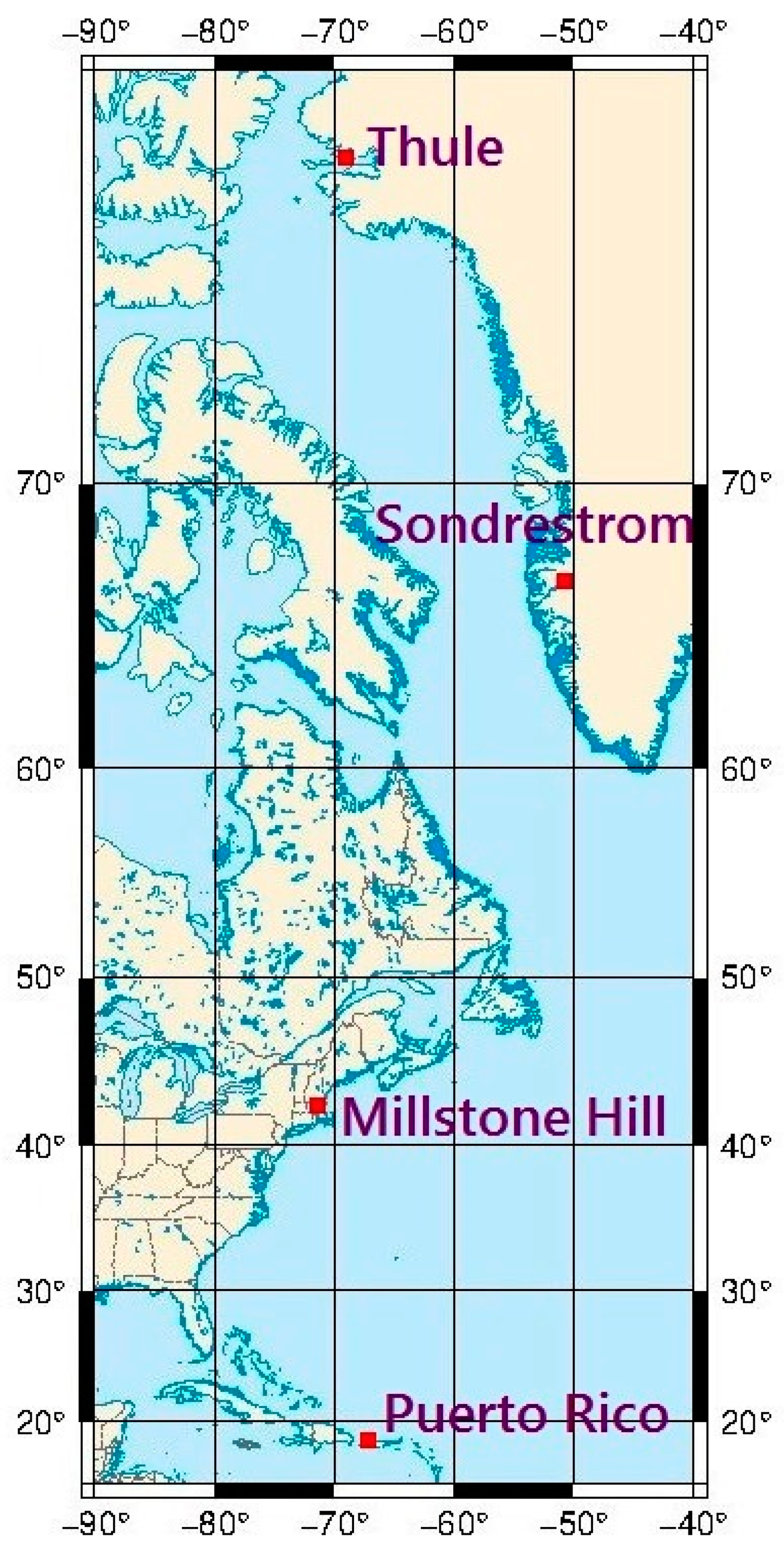

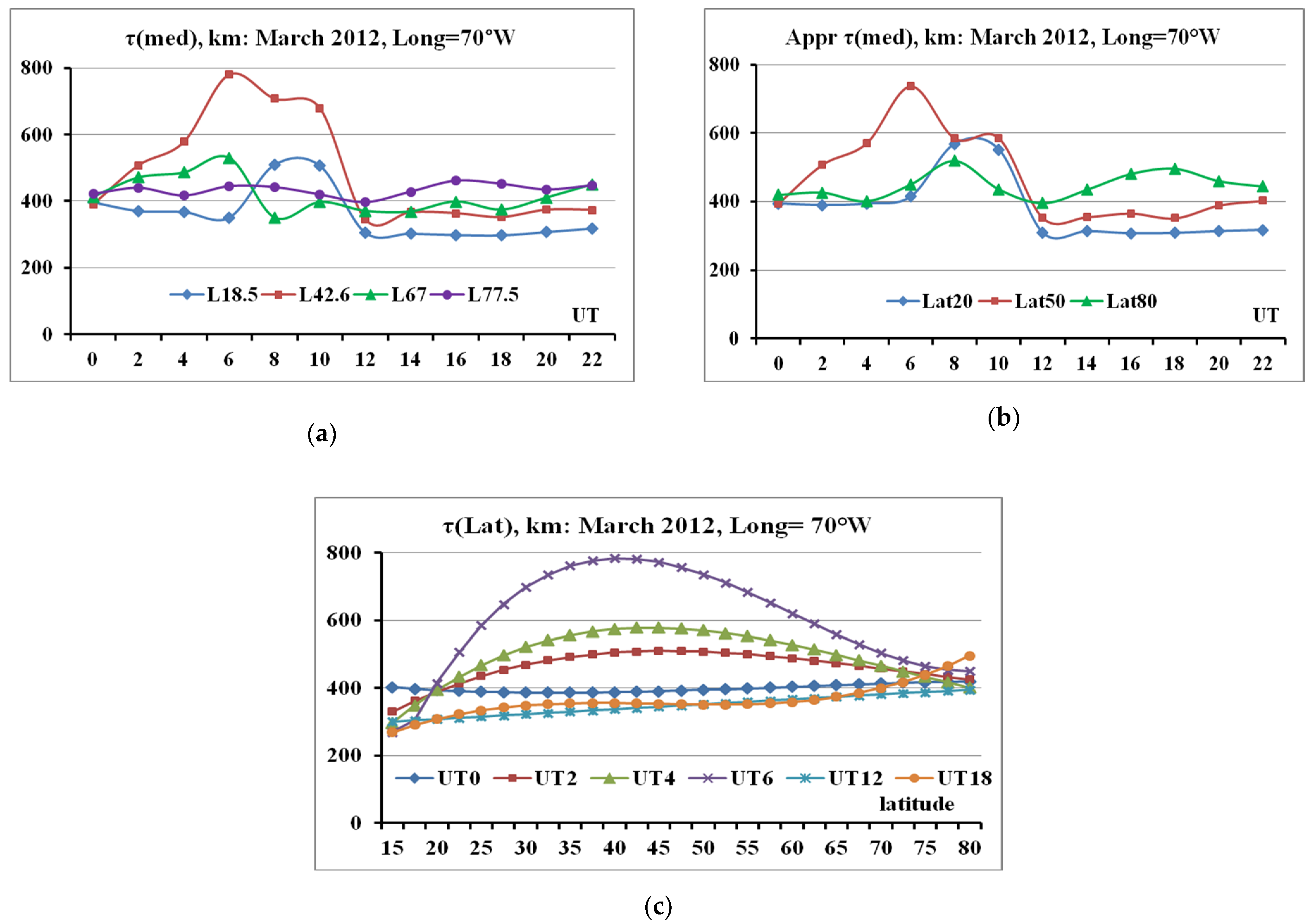
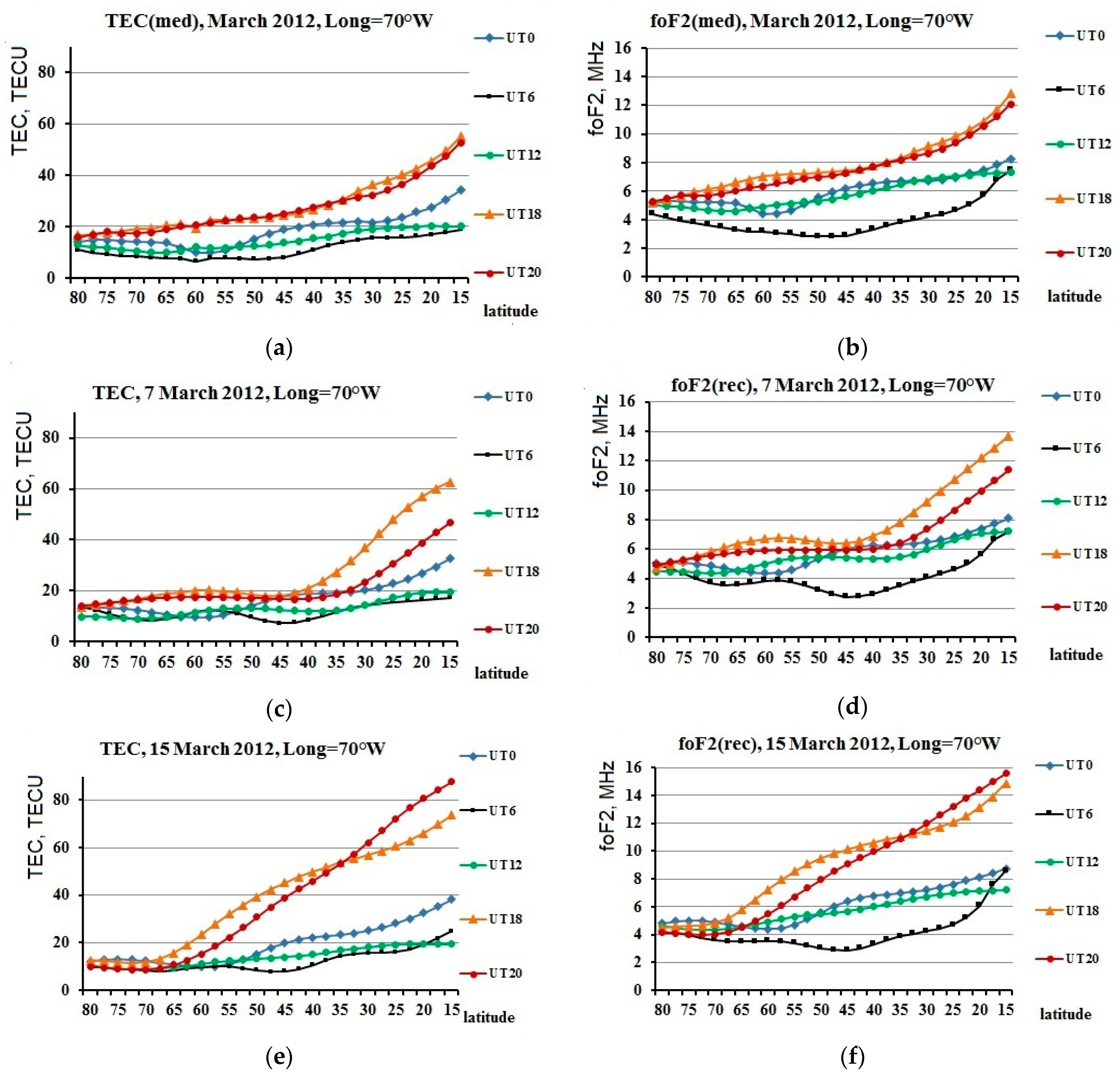
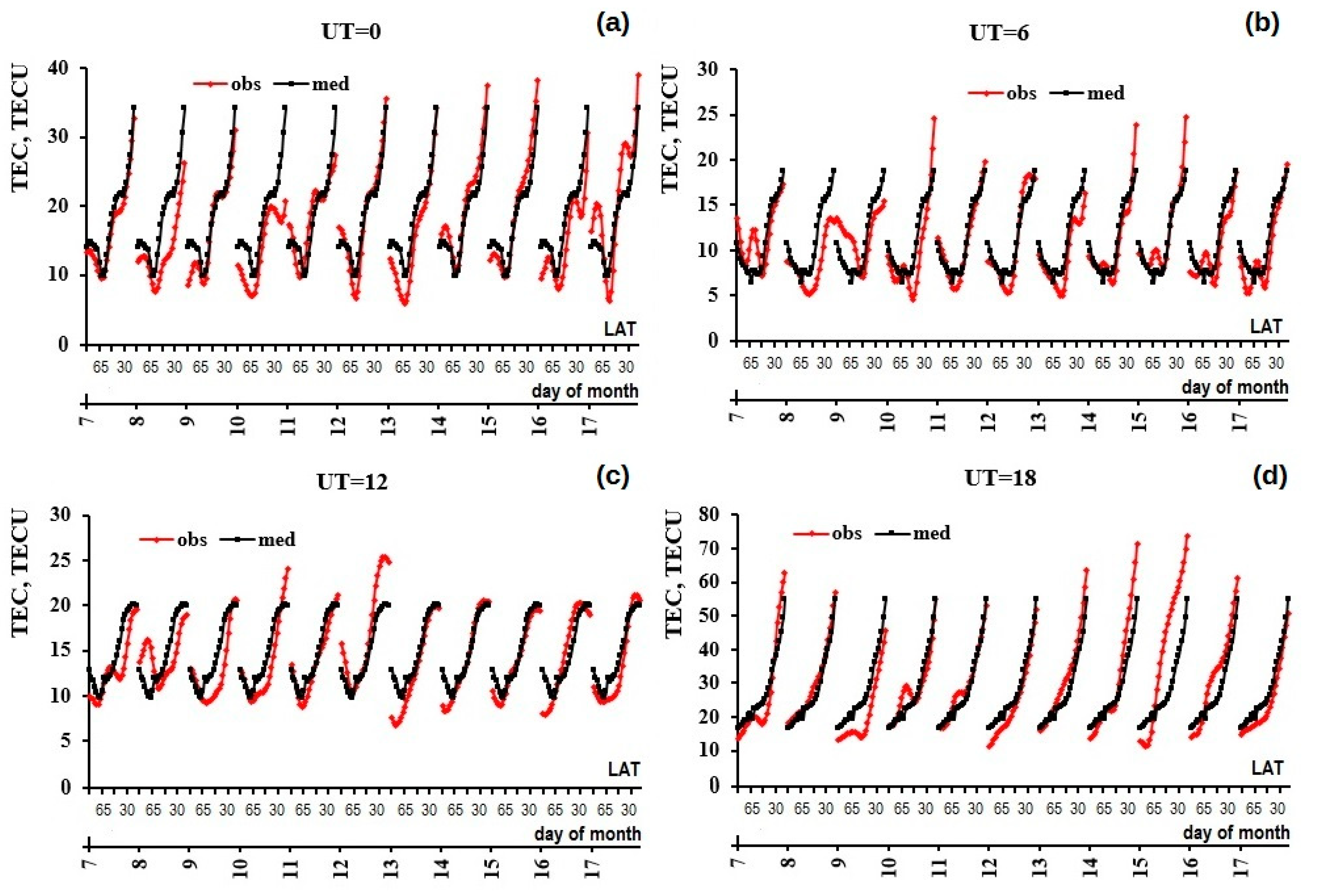
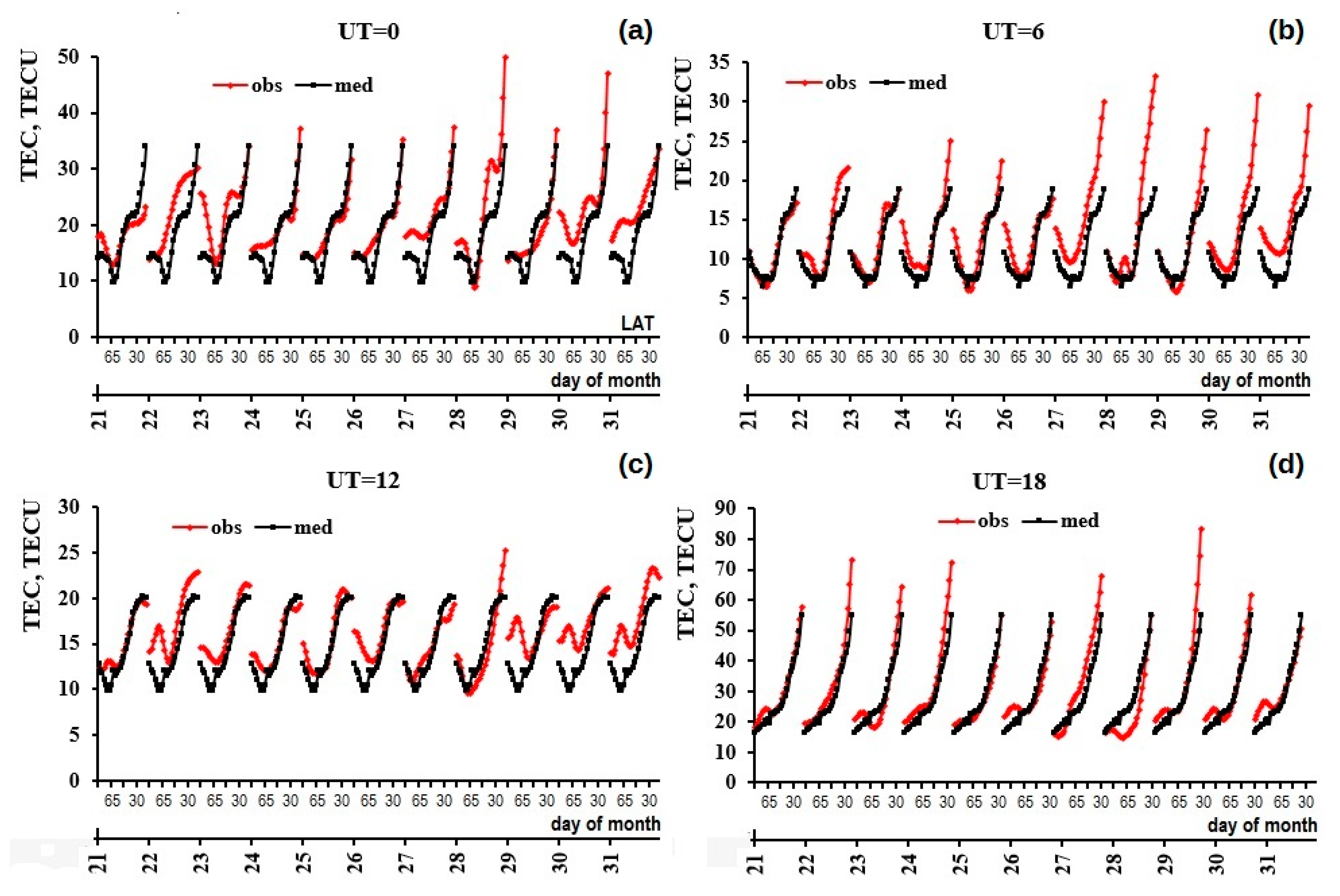
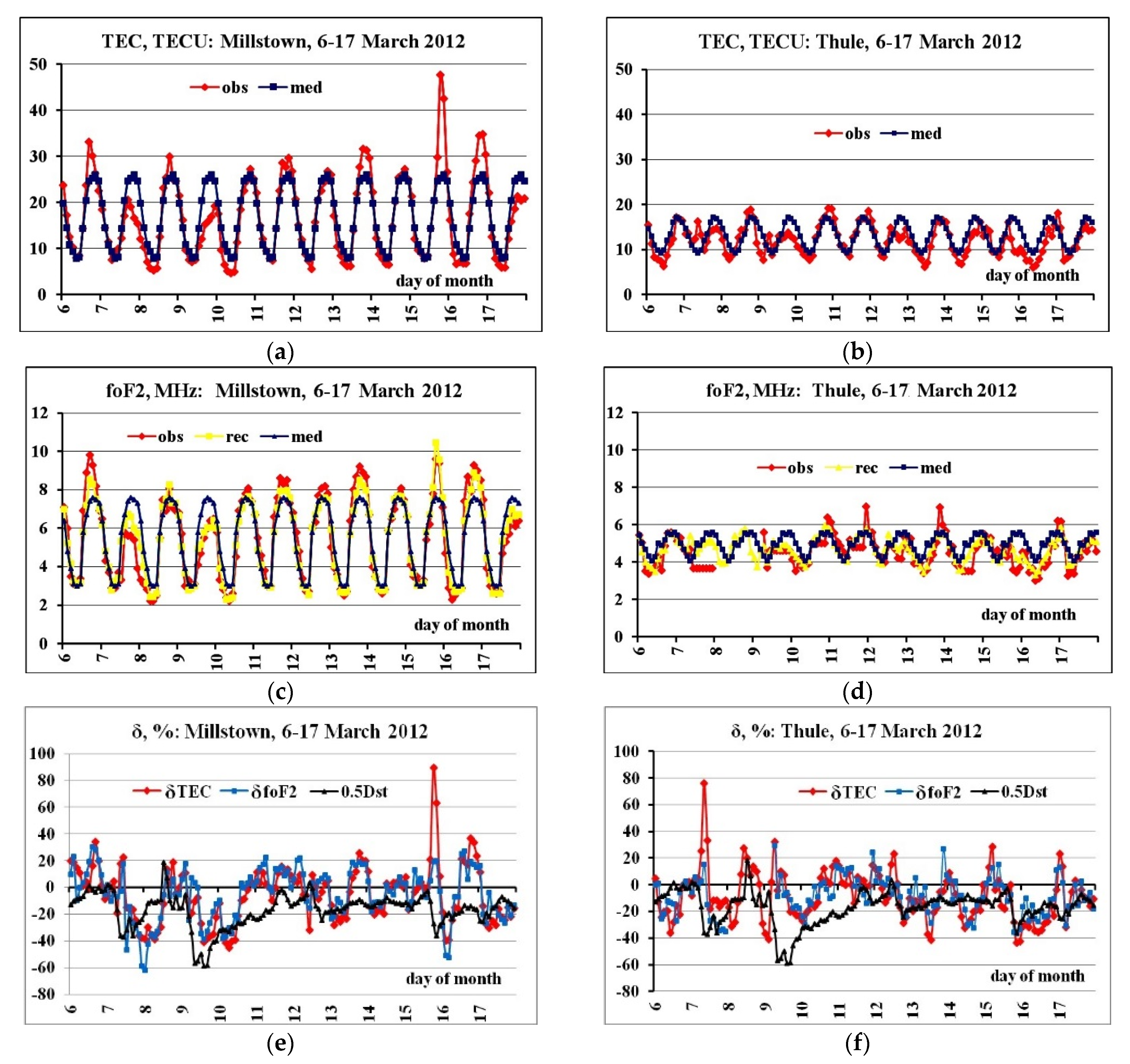
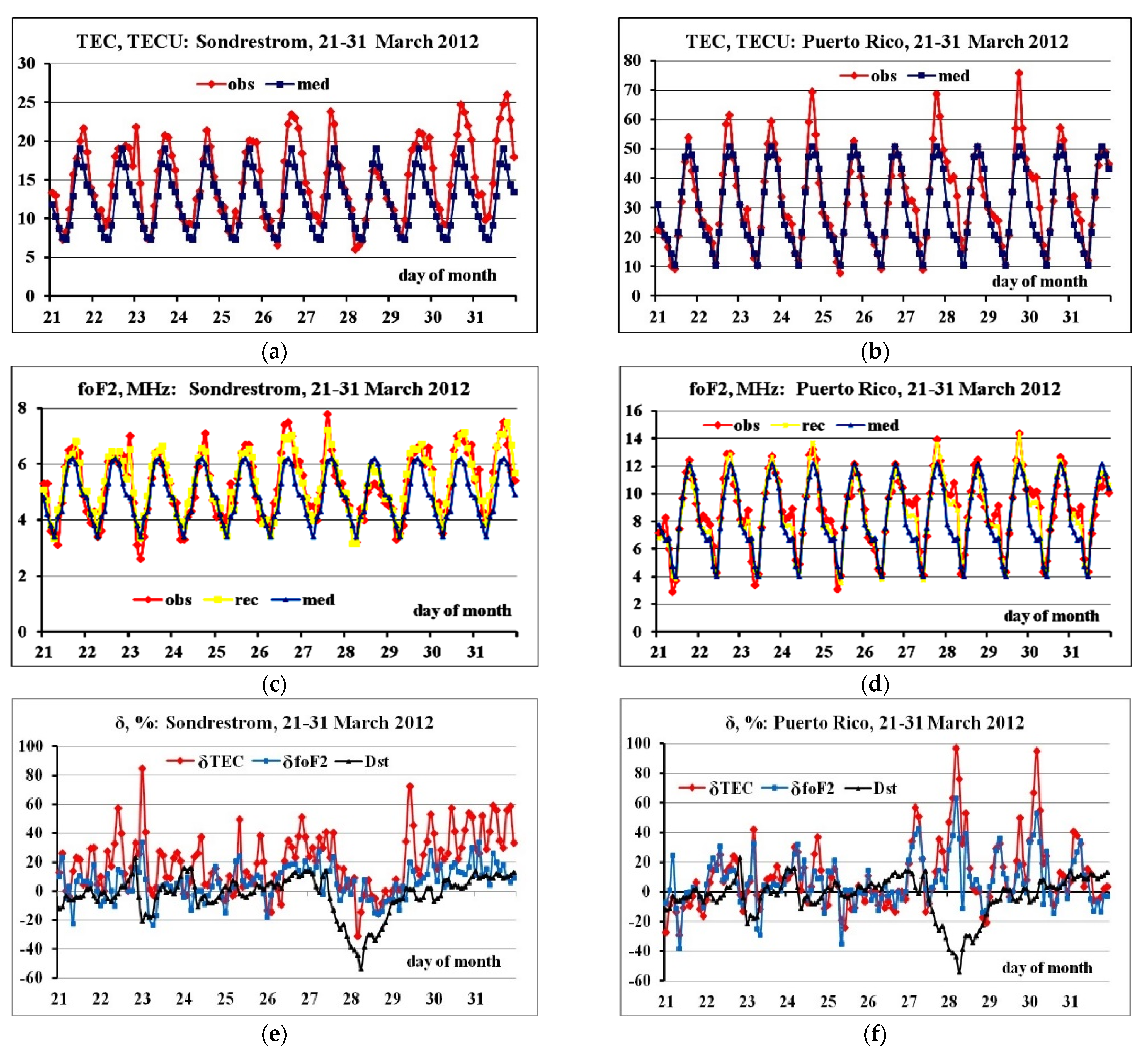
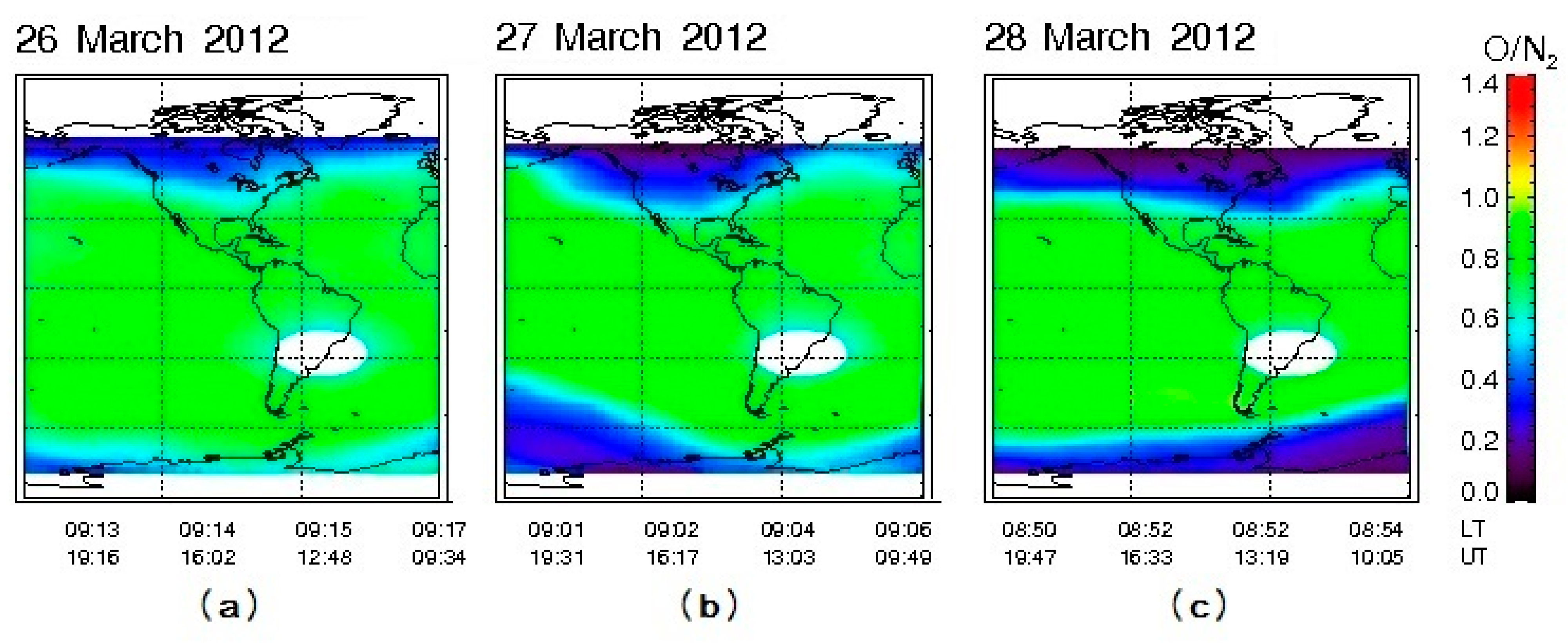
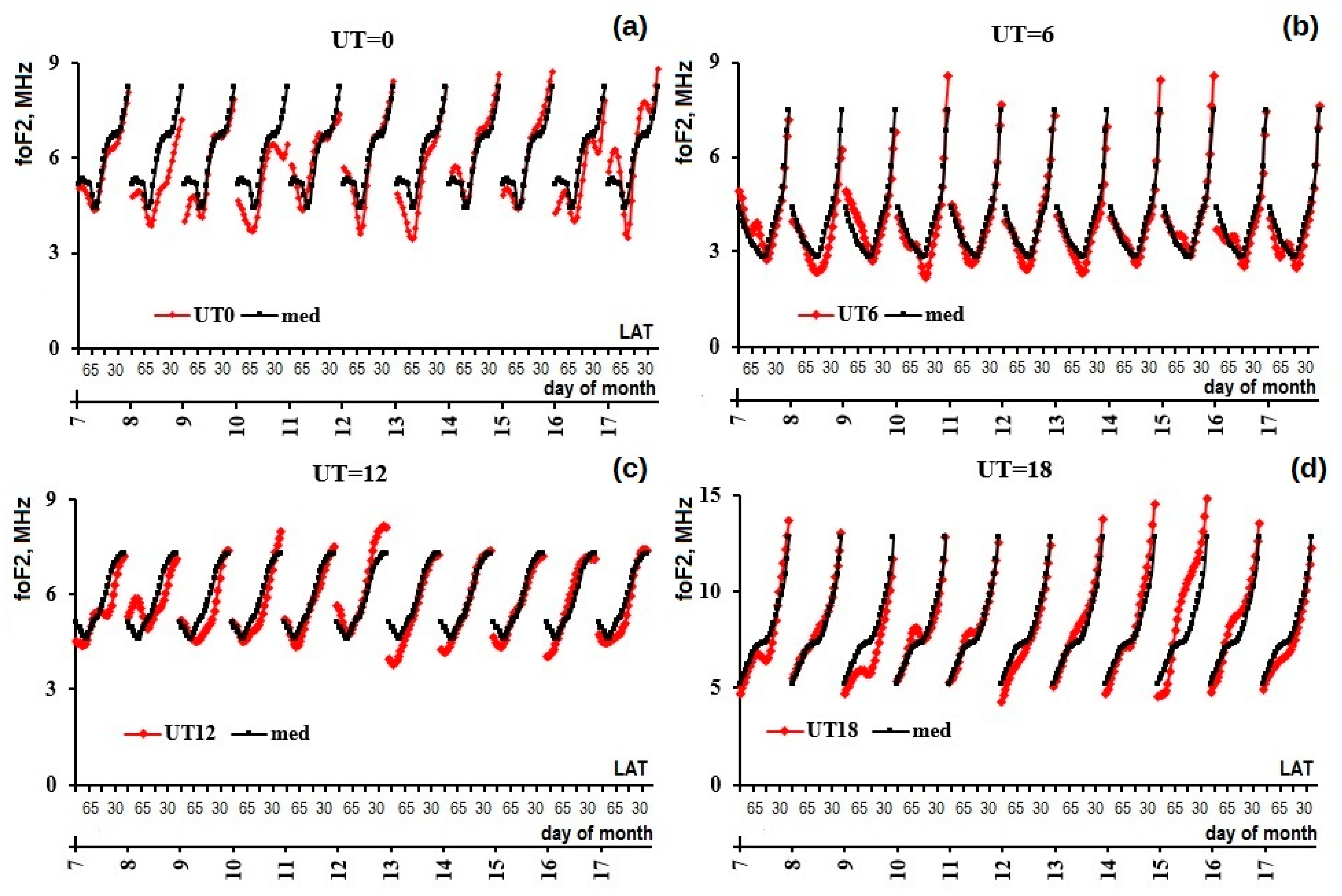
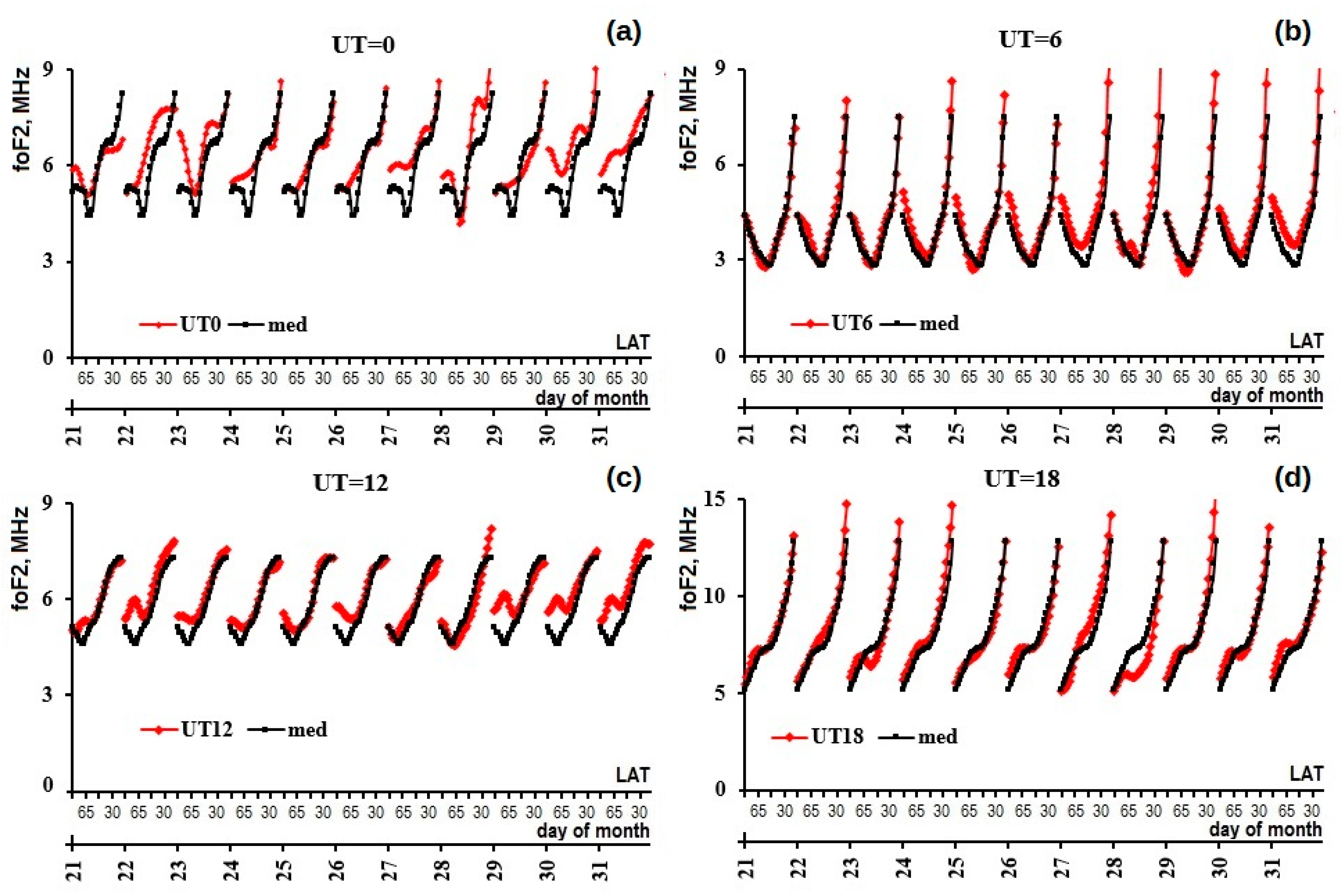

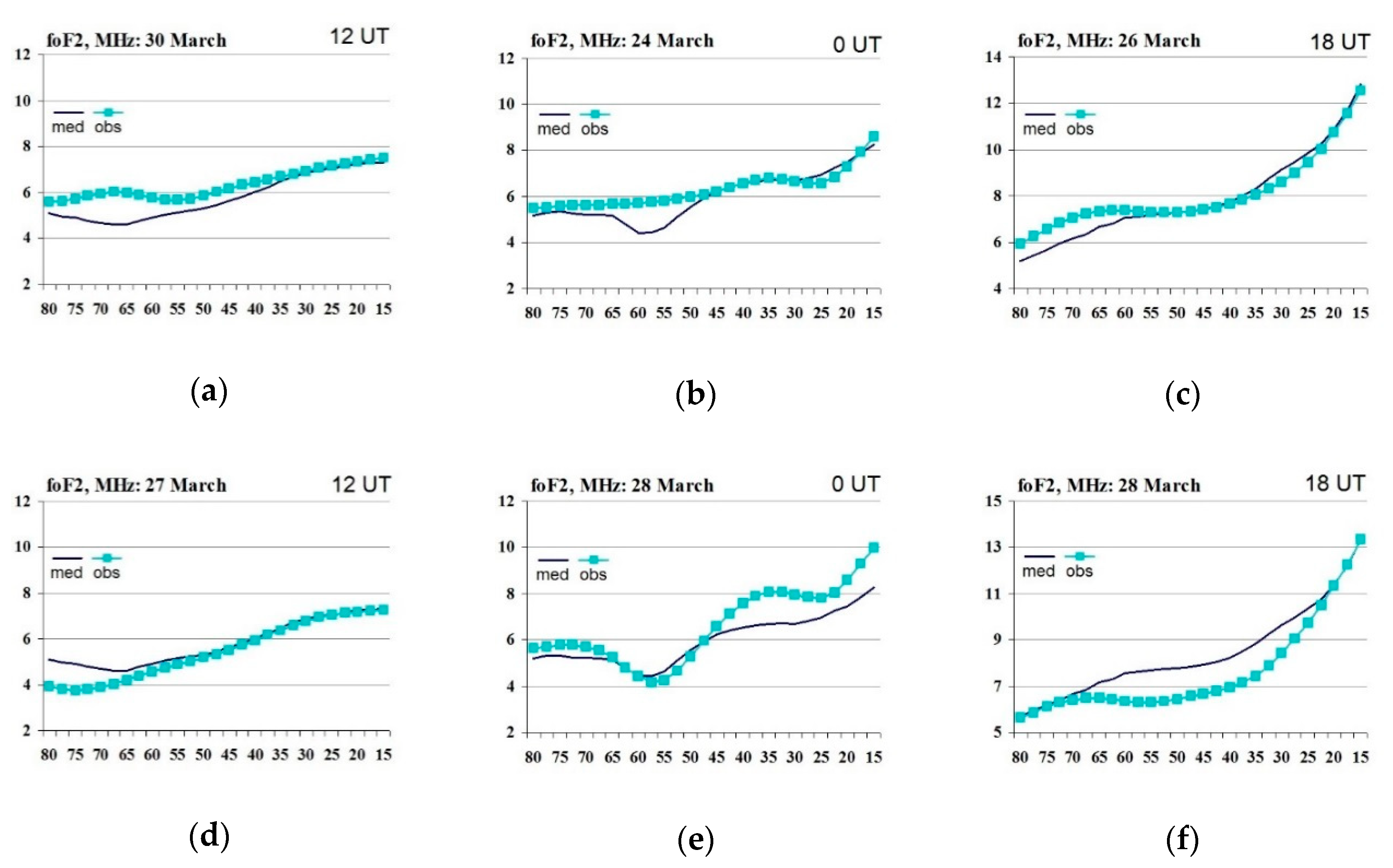
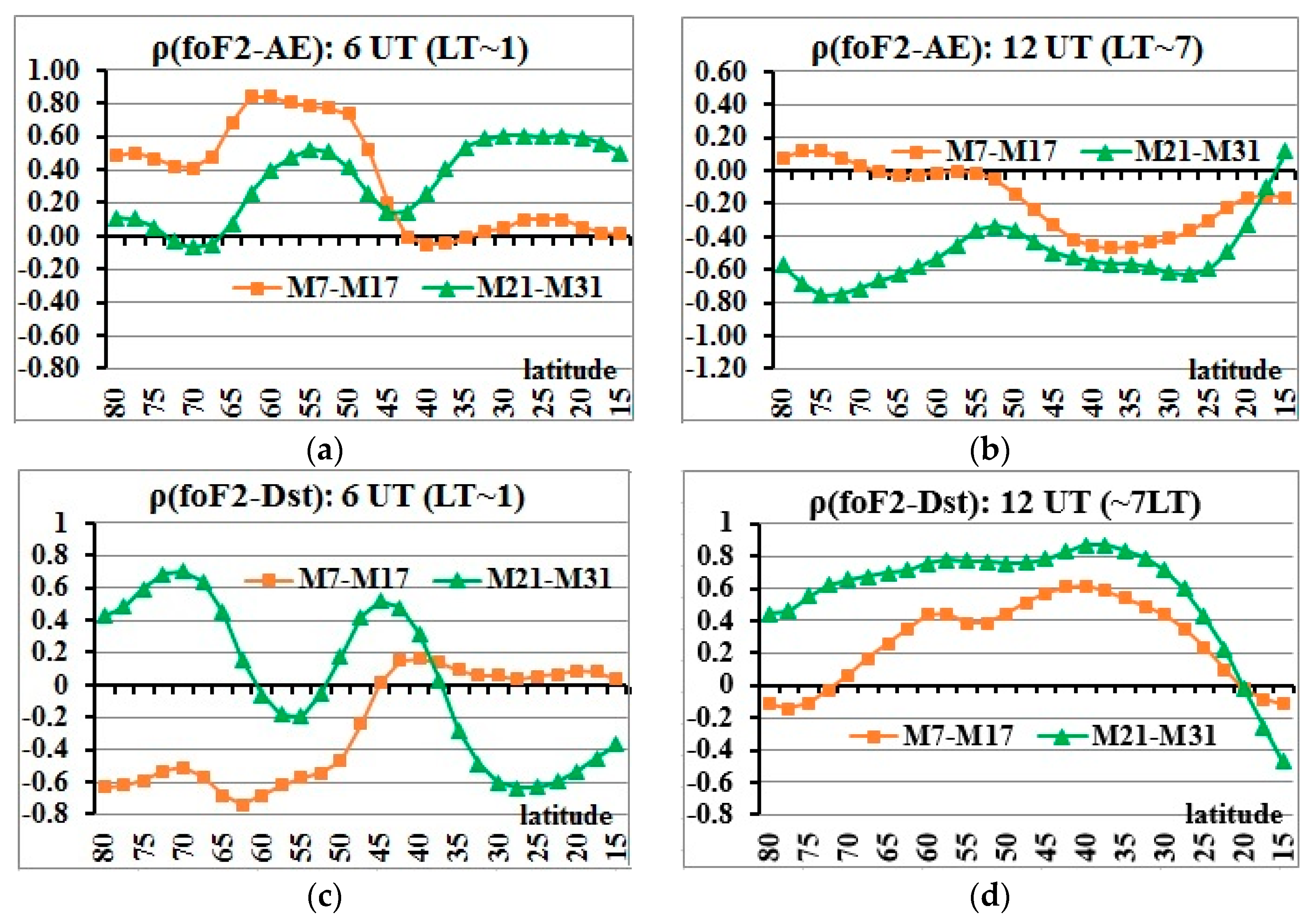
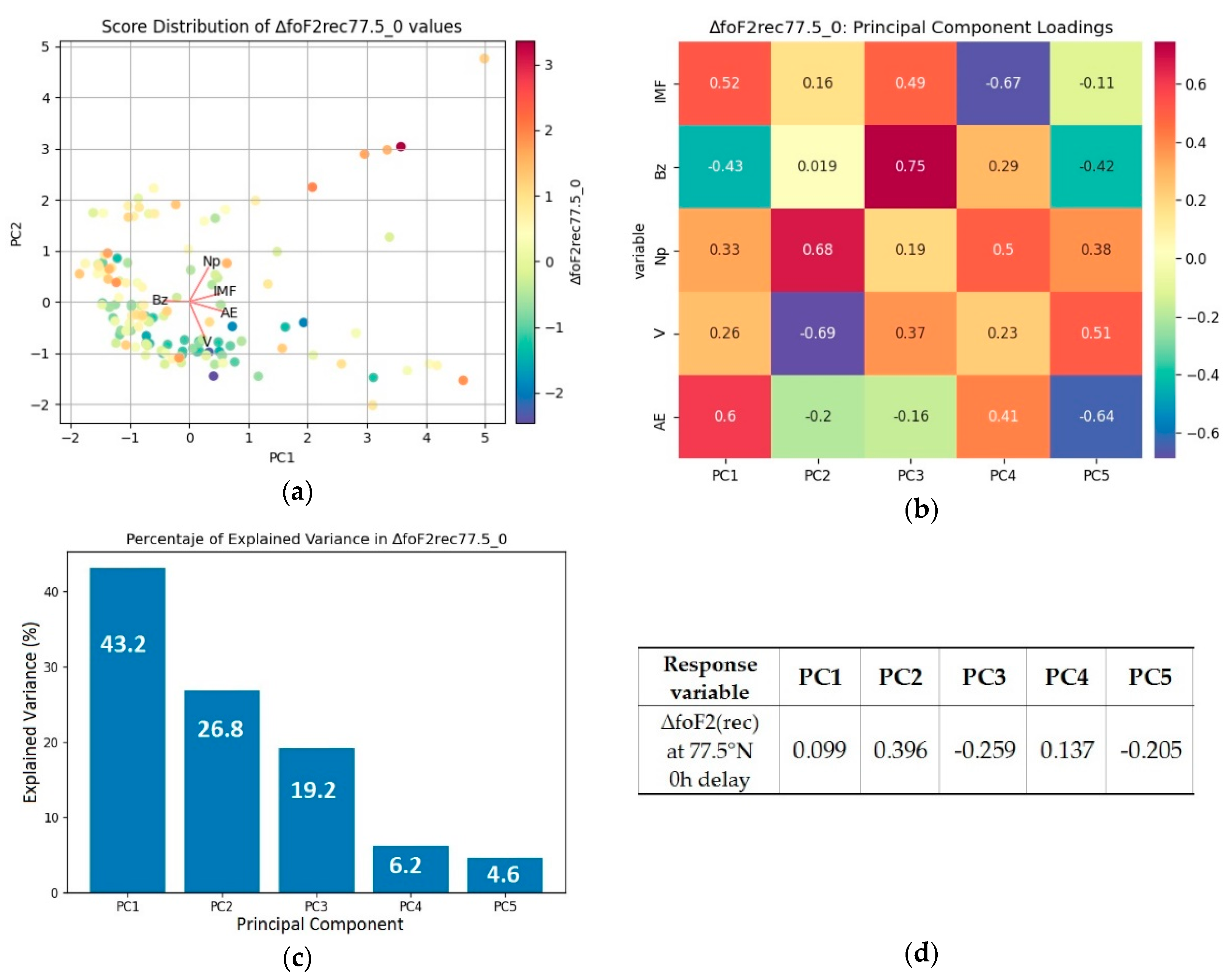
| Storm № | MP Beginning | RP Beginning | Minimum Dst Value | Maximum Kp Value |
|---|---|---|---|---|
| 1 | 7 March ~04 UT | 7 March ~09 UT | −88 nT | 6 |
| 2 | 9 March ~01 UT | 9 March ~08 UT | −145 nT | 8 |
| 3 | 12 March ~10 UT | 12 March ~16 UT | −64 nT | 6 |
| 4 | 15 March ~14 UT | 15 March ~20 UT | −88 nT | 6 |
| 5 | 27 March ~10 UT | 28 March ~04 UT | −68 nT | 5 |
| Ionospheric Response Delay | HL: 77.5° N | HL: 67.5° N | ML: 42.5° N | LL: 17.5° N |
|---|---|---|---|---|
| (87.2° N) | (77.2° N) | (52.2° N) | (27.3° N) | |
| 0 h | V(40%) | V(35%) | IMF(37%) | AE(43%) |
| Np(23%) | IMF(26%) | V(25%) | Bz(28%) | |
| AE(20%) | Np(23%) | AE(22%) | IMF(19%) | |
| 2 h | Bz(30%) V(27%) Np(23%) | V(44%) AE(19%) Np(18%) | IMF(49%) V(28%) Bz(21%) | AE(53%) |
| IMF(18%) | ||||
| Bz(15%) | ||||
| Np(14%) | ||||
| 4 h | V(54%) Bz(29%) | V(42%) | AE(39%) Bz(30%) | AE(64%) |
| AE(30%) | IMF(17%) | |||
| IMF(13%) | V(17%) |
| Hour | HL: 77.5° N | HL: 67.5° N | ML: 42.5° N | LL: 17.5° N |
|---|---|---|---|---|
| (87.2° N) | (77.2° N) | (52.2° N) | (27.3° N) | |
| 0 UT (~19 LT) | Np(38) IMF(34) | Np(35) V(32) IMF(30) | IMF(36) Bz(36) Np(20) | V(26)Np(23)Bz(22)AE(21) |
| Np(30)V(27)IMF(23)O/N2(16) 1 | IMF(37) Bz(32) O/N2(16) 1 | |||
| 6 UT (~1 LT) | IMF(35) V(25) | IMF(43) Np(31) V(19) | Np(34) Bz(32) | IMF(40)AE(32)V(20) |
| IMF(39) Np(32) V(23) 1 | Np(31) Bz(30) O/N2(26) 1 | |||
| 12 UT (~7 LT) | Bz(33)AE(28)V(28) | Bz(36) IMF(21) | Np(28)AE(23)V(23)IMF(19) | IMF(37)Np(34) |
| Bz(34) IMF(22) 1 | Np(28) O/N2(28) 1 | |||
| 18 UT (~13 LT) | Bz(33)Np(28)V(24) | Np(27) V(27) | Bz(41) IMF(30) AE(22) | Np(26)AE(24) V(22) |
| O/N2(40) AE(35) 1 | O/N2(39) AE(28) 1 |
| Ionospheric Response Delay | HL: 77.5° N | HL: 67.5° N | ML: 42.5° N | LL: 17.5° N |
|---|---|---|---|---|
| (87.2° N) | (77.2° N) | (52.2° N) | (27.3° N) | |
| 0 h | Bz(54%) V(27%) | Bz(27%) IMF(26%) V(23%) AE(16%) | IMF(50%) V(26%) Np(18%) | AE(36%) Bz(23%) |
| 2 h | AE(52%) V(30%) | AE(35%) IMF(27%) V(26%) | V(38%) IMF(34%) | AE(42%) V(32%) |
| 4 h | AE(55%) | AE(37%) V(26%) IMF(24%) | V(29%) Bz(21%) IMF(20%) | AE(36%) V(31%) |
| Hour | HL: 77.5° N | HL: 67.5° N | ML: 42.5° N | LL: 17.5° N |
|---|---|---|---|---|
| (87.2° N) | (77.2° N) | (52.2° N) | (27.3° N) | |
| 0 UT (~19 LT) | Bz(44) AE(31) | IMF(39) AE(22) Bz(19) | AE(34) IMF(32) Bz(20) | AE(44) Bz(26) |
| AE(33) Bz(27) 1 | AE(39) Bz(26) 1 | |||
| 6 UT (~1 LT) | AE(37) Np(30) | AE(42) Bz(24) IMF(21) | AE(42) Bz(26) IMF(24) | AE(38) Np(32) |
| AE(43) Bz(26) IMF(20) 1 | AE(41) Bz(27) 1 | |||
| 12 UT (~7 LT) | AE(35) Bz(35) IMF(21) | AE(46) IMF(19) Bz(18) | AE(45) Bz(20) IMF(18) | Np(32)IMF(25)Bz(24) |
| AE(31) Bz(31) 1 | AE(45) Bz(20) 1 | |||
| 18 UT (~13 LT) | Bz(49)Np(18)AE(16)IMF(16) | AE(63) | AE(42) Bz(25) | Bz(32)AE(30)IMF(19) |
| AE(63) 1 | O/N2(28)Np(26)AE(22) 1 |
Publisher’s Note: MDPI stays neutral with regard to jurisdictional claims in published maps and institutional affiliations. |
© 2021 by the authors. Licensee MDPI, Basel, Switzerland. This article is an open access article distributed under the terms and conditions of the Creative Commons Attribution (CC BY) license (http://creativecommons.org/licenses/by/4.0/).
Share and Cite
Sergeeva, M.A.; Maltseva, O.A.; Caraballo, R.; Gonzalez-Esparza, J.A.; Corona-Romero, P. Latitudinal Dependence of the Ionospheric Slab Thickness for Estimation of Ionospheric Response to Geomagnetic Storms. Atmosphere 2021, 12, 164. https://doi.org/10.3390/atmos12020164
Sergeeva MA, Maltseva OA, Caraballo R, Gonzalez-Esparza JA, Corona-Romero P. Latitudinal Dependence of the Ionospheric Slab Thickness for Estimation of Ionospheric Response to Geomagnetic Storms. Atmosphere. 2021; 12(2):164. https://doi.org/10.3390/atmos12020164
Chicago/Turabian StyleSergeeva, Maria A., Olga A. Maltseva, Ramon Caraballo, Juan Americo Gonzalez-Esparza, and Pedro Corona-Romero. 2021. "Latitudinal Dependence of the Ionospheric Slab Thickness for Estimation of Ionospheric Response to Geomagnetic Storms" Atmosphere 12, no. 2: 164. https://doi.org/10.3390/atmos12020164
APA StyleSergeeva, M. A., Maltseva, O. A., Caraballo, R., Gonzalez-Esparza, J. A., & Corona-Romero, P. (2021). Latitudinal Dependence of the Ionospheric Slab Thickness for Estimation of Ionospheric Response to Geomagnetic Storms. Atmosphere, 12(2), 164. https://doi.org/10.3390/atmos12020164







